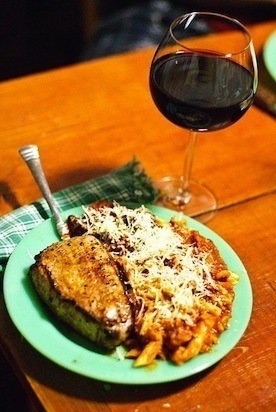Take An Amarone To Dinner... Or Lunch!
"It's a shame more people don't drink Amarone with their meals," says Baroness Barbara de Rham as she samples a decanted bottle of the 2004 Le Ragose and gives a nod to the waiter at Becco in New York City's theater district to pour it to her lunch-time guests. "Because Amarones are big wines, people often want to just sip them or have them after a meal. They sometimes have the impression that Amarones are dessert wines."
The Le Ragose is a big wine, but an elegant one — aromas and tastes of ripe berries, neither sweet nor jammy, followed by lots of food-loving dried spices and hints of anise and dark chocolate in the finish. It goes perfectly with the meaty osso bucco that soon comes steaming to the table.
De Rham's late husband, Armando, was one of the first to ship fine Italian wines to the United States in the early 1970's, and she has continued his work, representing about 40 wineries, mostly small, family-owned ones, from her base in Florence. But she is partial to Amarone.
Amarone — or, more correctly, Amarone della Valpolicella Classico from the region just outside Verona — is made from air drying red grapes, ideally with a high proportion of Corvina, in the weeks after they are harvested. The drying or raisination of the grapes concentrates the sugars and flavors that give Amarone its fruit intensity and also provides high alcohols, normally 14 to 16 percent. It is then aged in wood and generally not released until five years after harvest — so the 2004 Le Ragose is still a young wine by Amarone standards.
Baby boomers who years ago were discovering California late-harvested Zinfandels also fell in love with Amarones — not as big, alcoholic, sweet, or jammy as Port, but a step up from the lighter Bordeaux-style reds that were in vogue in the '70s and '80s. During this period, some of Amarones were indeed sweeter, and the image stuck.
But during a presentation held by producers of Amarones last fall, most of the wines I tasted were excellent food wines, dry and balanced, although a couple might have overpowered most things on a dinner plate. Three things seem to be key when considering whether you should take an Amarone to dinner — it shouldn't be so jammy as to appear sweet, the tannins must be well-integrated, not harsh nor bitter, and the alcohol cannot make the wine seem hot, volatile or out-of-balance.
If those things are in control — and with wines from good producers these days, they are – then a young, five- to-10-year-old Amarone should have the dried fruits, dried spices and dark notes of chocolate that are food-friendly. Older wines are even better.
What kinds of food? Wine and food pairings depend greatly on individual palates, but in addition to osso buco, other good choices include hearty stews with or without meat, rare duck breast, wild boar, mushroom tarts, spicy crusted lamb chops and pasta with red sauce and sausage. Of course, pairing Amarone with the cheese course — especially creamy or aged cow's-milk cheeses — is a natural.
If you're not experienced with Amarones, ask your wine retailer or sommelier for recommendations. And if you have a nice one resting in your cellar, invite it to dinner — or a big Sunday lunch.
